A
variety of aircraft have been used in the troop carrier mission since
it first came into being in the dark days of early World War II. Since
little thought had been given to using airplanes to transport troops
into battle, the first troop carrier aircraft were militarized versions
of existing civil aircraft that had been developed for airline service.
As the war continued, new types were designed with military uses in
mind.
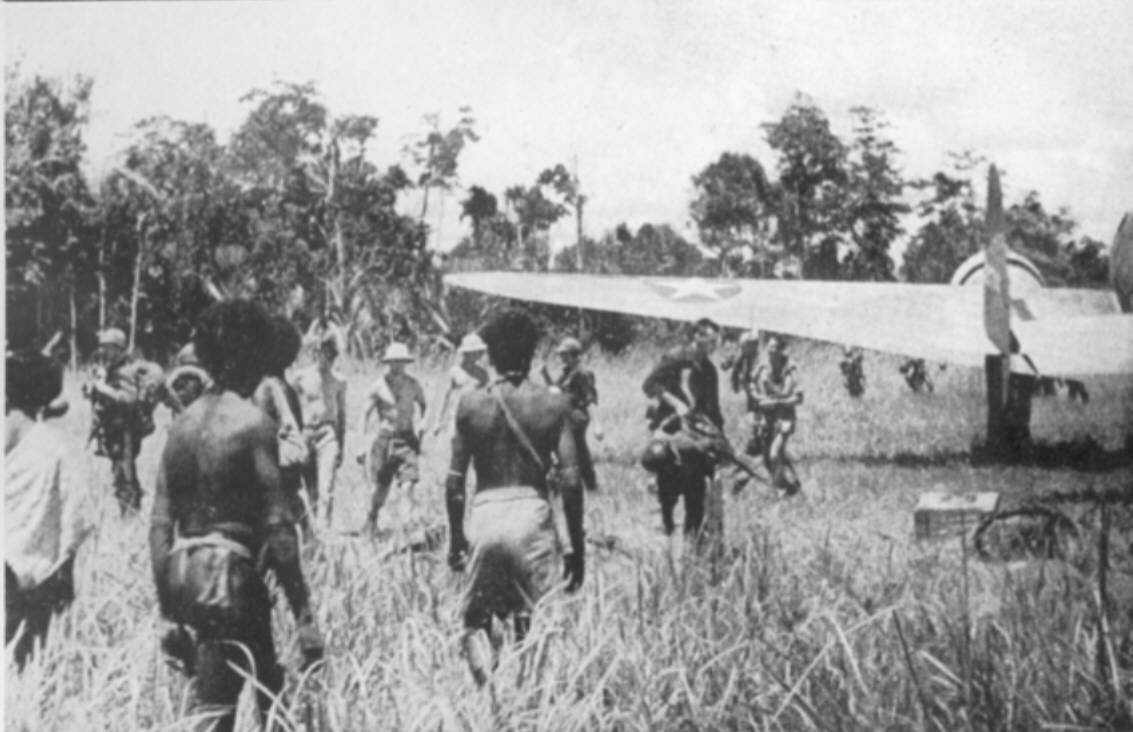 One
of the first civil aircraft to be used in the troop carrier role was
the famous Lockheed Lodestar, which the Army designated as the C-60. A
trio of Lodestars were on their way to the Philippines when World War
II broke and out and were diverted to Australia, where they were
appropriated by the Army and assigned to the Far East Air Forces Air
Transport Command, the predecessor of troop carrier forces in the
Southwest Pacific. The C-60 in the photo above was delivering supplies
to the forward airfield at Wanigela Mission in Papaua, New Guinea where
MacArthur's forces established an airhead for the attack on Buna.
One
of the first civil aircraft to be used in the troop carrier role was
the famous Lockheed Lodestar, which the Army designated as the C-60. A
trio of Lodestars were on their way to the Philippines when World War
II broke and out and were diverted to Australia, where they were
appropriated by the Army and assigned to the Far East Air Forces Air
Transport Command, the predecessor of troop carrier forces in the
Southwest Pacific. The C-60 in the photo above was delivering supplies
to the forward airfield at Wanigela Mission in Papaua, New Guinea where
MacArthur's forces established an airhead for the attack on Buna.
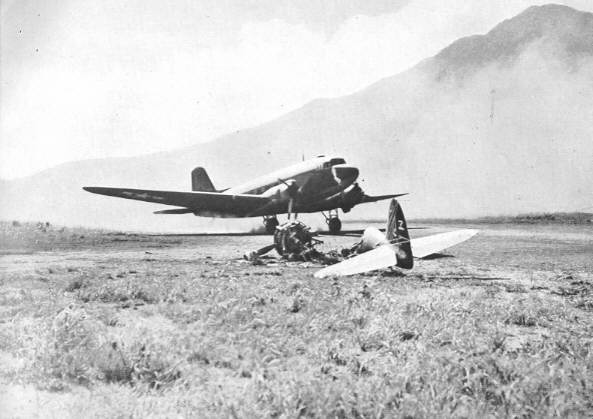 The
most widely used troop carrier aircraft in World War II was the
militarized Douglas DC-3, which saw service as C-47s and C-53s, with
the difference being that the C-47 was designed to transport cargo
while the C-53 was purchased as a troop carrier without the wide cargo
door. By the end of the war the C-47 designation has become standard.
C-47s served in every theater of teh war and in a variety of roles.
General Dwight Eisenhower referred to the C-47 as one of the three most
important weapons of the war. C-47s also saw wide service in the Korean
War and continued in service into the Vietnam War, when most were
converted into fixed-wing gunships.
The
most widely used troop carrier aircraft in World War II was the
militarized Douglas DC-3, which saw service as C-47s and C-53s, with
the difference being that the C-47 was designed to transport cargo
while the C-53 was purchased as a troop carrier without the wide cargo
door. By the end of the war the C-47 designation has become standard.
C-47s served in every theater of teh war and in a variety of roles.
General Dwight Eisenhower referred to the C-47 as one of the three most
important weapons of the war. C-47s also saw wide service in the Korean
War and continued in service into the Vietnam War, when most were
converted into fixed-wing gunships.
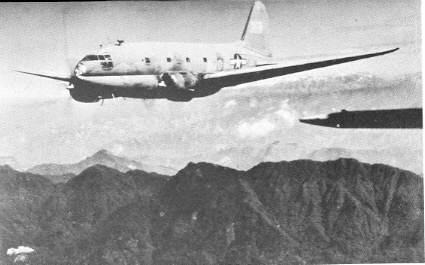 Another
airline type that saw wide service in World War II was the Curtiss
C-46, a large twin-engine transport that was used primarily by the Air
Transport Command, particular on the India-China Ferry. The C-46s large
cabin and increased payload led to its adapatation as a troop carrier
transport, but design deficencies quickly revealed that it was
ill-suited for combat. C-46s were only used in one airborne operation,
the crossing of the Rhine in March 1945. The fuel system was prone to
leaks and fuel would run into the belly and pool up, and be easily set
off by tracer bullets. So many were lost in the Rhine operation that
General Matthew Ridgeway, the senior US airborne officer in Europe,
decreed that his troopers would never again jump from C-46s!
Fortunately, the war in Europe ended a few weeks later. Most C-46s went
to reserve units after the war, but were recalled for Korea. C-46s
continued in service into the 1960s, mostly in air commando units
operating in Central America.
Another
airline type that saw wide service in World War II was the Curtiss
C-46, a large twin-engine transport that was used primarily by the Air
Transport Command, particular on the India-China Ferry. The C-46s large
cabin and increased payload led to its adapatation as a troop carrier
transport, but design deficencies quickly revealed that it was
ill-suited for combat. C-46s were only used in one airborne operation,
the crossing of the Rhine in March 1945. The fuel system was prone to
leaks and fuel would run into the belly and pool up, and be easily set
off by tracer bullets. So many were lost in the Rhine operation that
General Matthew Ridgeway, the senior US airborne officer in Europe,
decreed that his troopers would never again jump from C-46s!
Fortunately, the war in Europe ended a few weeks later. Most C-46s went
to reserve units after the war, but were recalled for Korea. C-46s
continued in service into the 1960s, mostly in air commando units
operating in Central America.
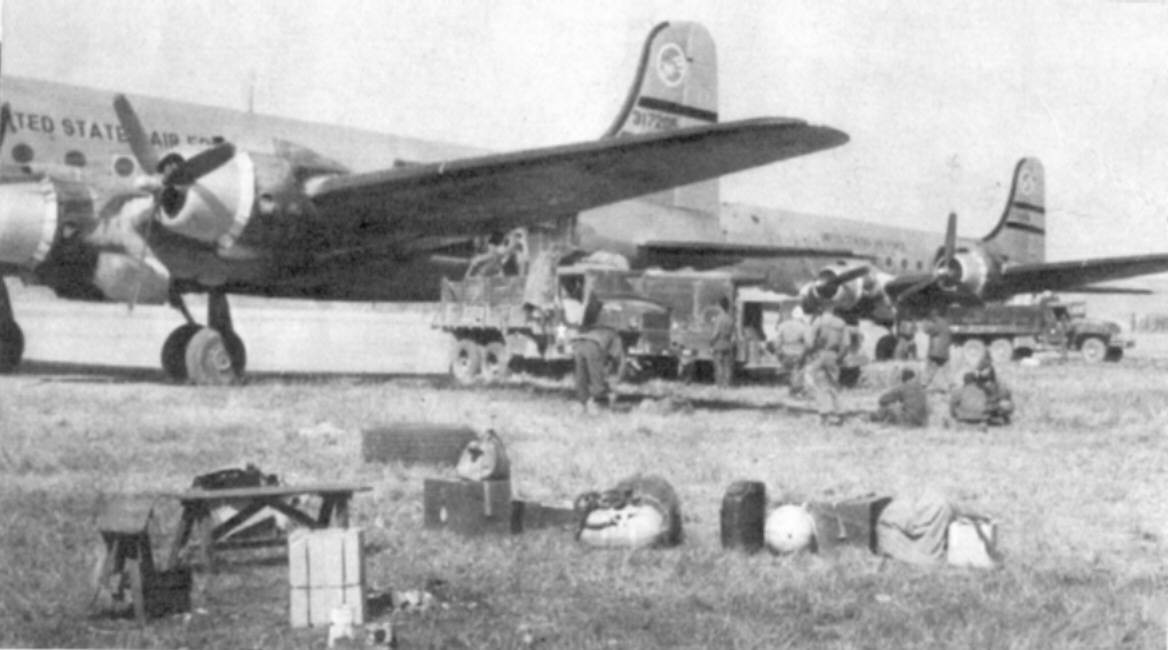
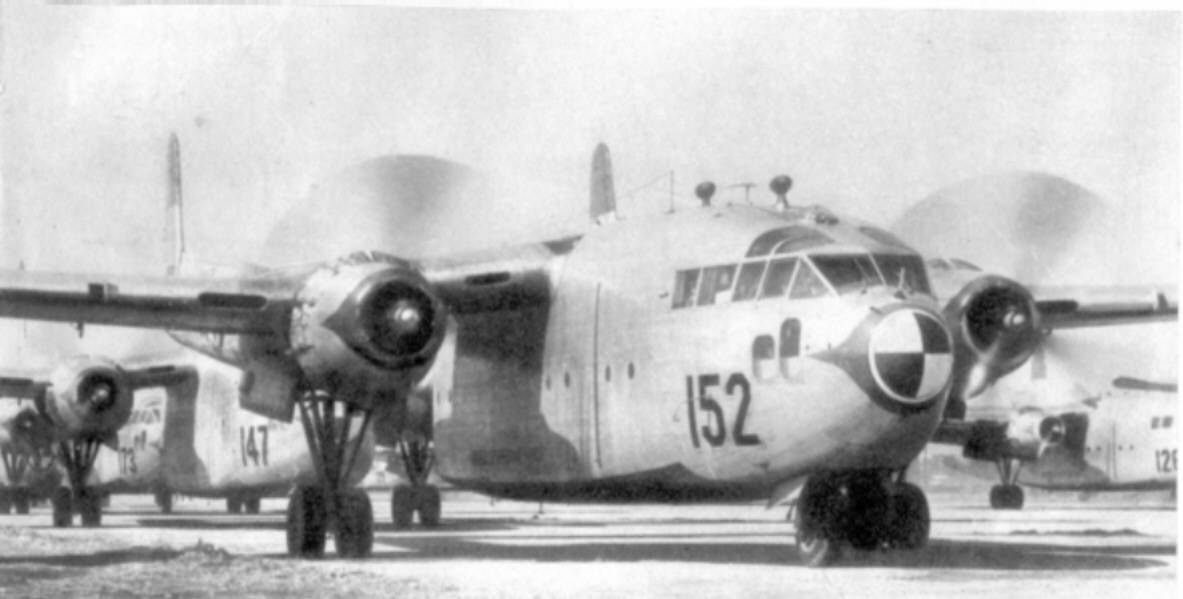 As
the troop carrier mission became crucial to US combat operations in
World War II, the Army sought new designs especially for troop carrier
use. The Fairchild Aircraft C-82 was the most successful of the new
designs, but
it was modified and became the C-119 in time for the Korean War. USAF
C-119s were "loaned" to France for service in Indo-China during the
French Indo-China War. The C-119 was the mainstay of troop carrier
operations through the 1950s. By the 1960s most C-119s had gone to the
reserves. In the mid-sixties many were converted to gunships and some
were given to South Vietnam where they served through the end of the
Vietnam War.
As
the troop carrier mission became crucial to US combat operations in
World War II, the Army sought new designs especially for troop carrier
use. The Fairchild Aircraft C-82 was the most successful of the new
designs, but
it was modified and became the C-119 in time for the Korean War. USAF
C-119s were "loaned" to France for service in Indo-China during the
French Indo-China War. The C-119 was the mainstay of troop carrier
operations through the 1950s. By the 1960s most C-119s had gone to the
reserves. In the mid-sixties many were converted to gunships and some
were given to South Vietnam where they served through the end of the
Vietnam War.
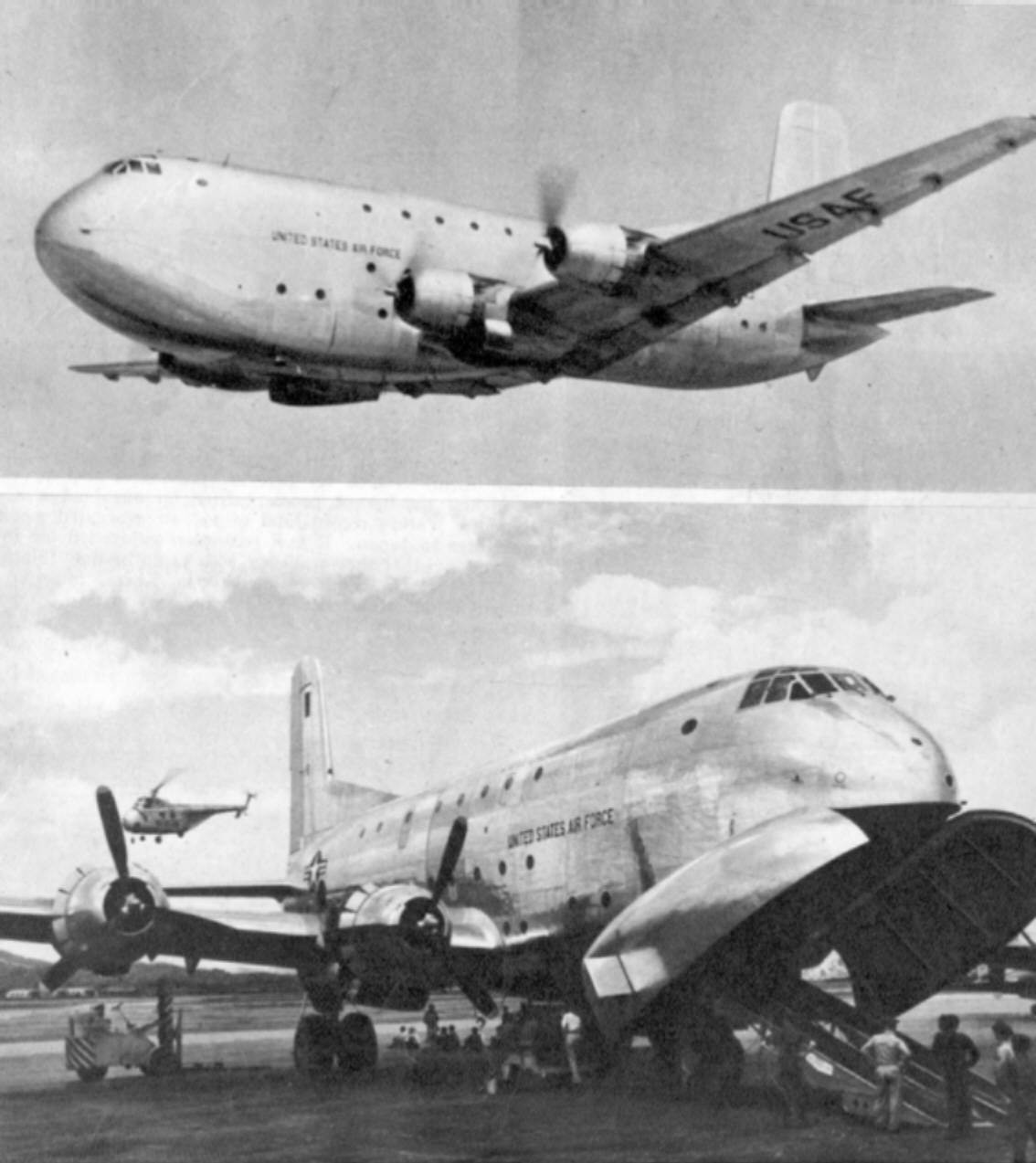 Before
World War II ended, the Army Air Forces sought a larger troop carrier
transport. Douglas designed the C-74, which was essentially an
oversized C-54, but it lacked troop carrier capabilities. In response
to a requirement for a large troop carrier aircraft, Douglas redesigned
the C-74 and increased the size of the fuselage. The result was the
C-123 Globemaster. The C-124 immediately became a focal point of
military politics as the commander of the Military Air Transport
Service which had been established in 1948 advocated that such a large
transport rightly belonged in MATS. A C-124 was sent to Japan for
operations into Korea and after the test proved successful, two
squadrons were established at Tachikawa. C-124s remained in TAC and
Pacific Air Forces until 1957 when the Air Force finally gave in to
MATS demands and transferred all of the huge transports to MATS,
although one squadon in Japan remained under PACAF operational control.
Before
World War II ended, the Army Air Forces sought a larger troop carrier
transport. Douglas designed the C-74, which was essentially an
oversized C-54, but it lacked troop carrier capabilities. In response
to a requirement for a large troop carrier aircraft, Douglas redesigned
the C-74 and increased the size of the fuselage. The result was the
C-123 Globemaster. The C-124 immediately became a focal point of
military politics as the commander of the Military Air Transport
Service which had been established in 1948 advocated that such a large
transport rightly belonged in MATS. A C-124 was sent to Japan for
operations into Korea and after the test proved successful, two
squadrons were established at Tachikawa. C-124s remained in TAC and
Pacific Air Forces until 1957 when the Air Force finally gave in to
MATS demands and transferred all of the huge transports to MATS,
although one squadon in Japan remained under PACAF operational control.
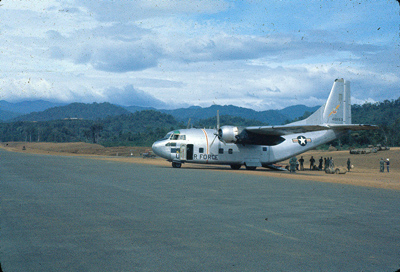 Another
Chase aircraft design was the C-123 Provider, which started out as an
all-metal glider. As the world entered the Jet Age, Fairchild decided
to convert it into a four-engine jet transport, but the Air Force
decided it cost too much. Fairchild then offered it as a twin-engine
assault transport, an airplane that could land on very short,
unimproved strips and function essentially as a powered glider. The
first C-123Bs went to a troop carrier squadron at Ardmore AFB,
Oklahoma. By the early 1960s the C-123s were being phased
out, with only a handful of squadrons still flying
them in the active Air Force while reserve squadrons at
Memphis, Tennessee and Birmingham, Alabama also operated
them. The two squadrons were called to active duty during
the Cuban Crisis. In 1961 a special conference in Saigon
determined that a major need of the South Vietnamese government in its
war against insurgents was air transportation and the Air Force
proposed that this need be met with C-123s. In early December a
squadron departed from Pope AFB, NC for Clark AB, Philippines as
Project MULE TRAIN. Within a few weeks the project had moved to Saigon.
They were joined a few months later by another squadron which deployed
as SAWBUCK. In 1963 the temporary duty C-123s and their crews and
support personnel were replaced by permanently assigned aircraft and
personnel drawn from the Air Force at large. Assigned to the 315th Air
Commando Group, C-123s would serve in Southeast Asia as short-range
assault transports until the early 1970s.
Another
Chase aircraft design was the C-123 Provider, which started out as an
all-metal glider. As the world entered the Jet Age, Fairchild decided
to convert it into a four-engine jet transport, but the Air Force
decided it cost too much. Fairchild then offered it as a twin-engine
assault transport, an airplane that could land on very short,
unimproved strips and function essentially as a powered glider. The
first C-123Bs went to a troop carrier squadron at Ardmore AFB,
Oklahoma. By the early 1960s the C-123s were being phased
out, with only a handful of squadrons still flying
them in the active Air Force while reserve squadrons at
Memphis, Tennessee and Birmingham, Alabama also operated
them. The two squadrons were called to active duty during
the Cuban Crisis. In 1961 a special conference in Saigon
determined that a major need of the South Vietnamese government in its
war against insurgents was air transportation and the Air Force
proposed that this need be met with C-123s. In early December a
squadron departed from Pope AFB, NC for Clark AB, Philippines as
Project MULE TRAIN. Within a few weeks the project had moved to Saigon.
They were joined a few months later by another squadron which deployed
as SAWBUCK. In 1963 the temporary duty C-123s and their crews and
support personnel were replaced by permanently assigned aircraft and
personnel drawn from the Air Force at large. Assigned to the 315th Air
Commando Group, C-123s would serve in Southeast Asia as short-range
assault transports until the early 1970s.
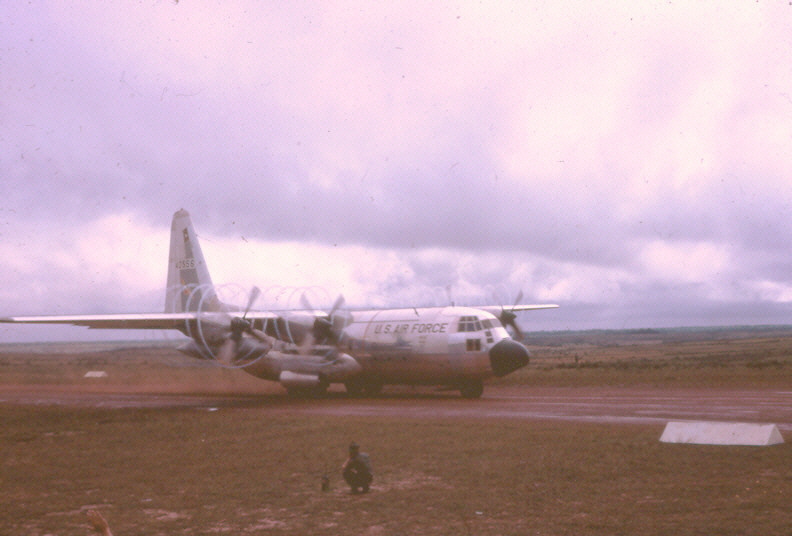 Developed
during the Korean War as a medium range transport with unimproved
runway capabilities, the Lockheed C-130 Hercules has become the
penultimate troop carrier transport. First flown in 1953, C-130s began
replacing C-119s in Tactical Air Command troop carrier squadrons
beginning in December 1956. Originally planned for six squadrons in the
United States and six overseas - three each in the Pacific and Europe -
by the mid-1960s there were twelve squadrons in the Pacific alone.
PACAF C-130s assigned to 315th Air Division were involved in Southeast
Asia from the beginning of hostilities as a logistical transport and in
June 1965 the first airplane were assigned to South Vietnam, although
on temporary duty status, for tactical operations. By 1968 C-130s were
heavily involved in the combat role as well as logistical supports.
315th Air Division C-130s were also involved in then-classified
"special operations" missions including flying forward air
controller/flare missions over the Ho Chi Minh Trail in Laos, dropping
leaflets over North Vietnam - and North Korea - and in several other
missions of a classified nature. In 1969 the 473rd Tactical Airlift
Wing began COMMANDO VAULT missions dropping 10,000-pound bombs, later
replaced by newly designed 15,000 pounders. By 1972 PACAF C-130s were
the only USAF tactical airlifters involved in the war in Vietnam, the
C-123s having been withdrawn or given to the South Vietnamese. In 1975
all USAF tactical airlift resources transferred to the Military Airlift
Command.
Developed
during the Korean War as a medium range transport with unimproved
runway capabilities, the Lockheed C-130 Hercules has become the
penultimate troop carrier transport. First flown in 1953, C-130s began
replacing C-119s in Tactical Air Command troop carrier squadrons
beginning in December 1956. Originally planned for six squadrons in the
United States and six overseas - three each in the Pacific and Europe -
by the mid-1960s there were twelve squadrons in the Pacific alone.
PACAF C-130s assigned to 315th Air Division were involved in Southeast
Asia from the beginning of hostilities as a logistical transport and in
June 1965 the first airplane were assigned to South Vietnam, although
on temporary duty status, for tactical operations. By 1968 C-130s were
heavily involved in the combat role as well as logistical supports.
315th Air Division C-130s were also involved in then-classified
"special operations" missions including flying forward air
controller/flare missions over the Ho Chi Minh Trail in Laos, dropping
leaflets over North Vietnam - and North Korea - and in several other
missions of a classified nature. In 1969 the 473rd Tactical Airlift
Wing began COMMANDO VAULT missions dropping 10,000-pound bombs, later
replaced by newly designed 15,000 pounders. By 1972 PACAF C-130s were
the only USAF tactical airlifters involved in the war in Vietnam, the
C-123s having been withdrawn or given to the South Vietnamese. In 1975
all USAF tactical airlift resources transferred to the Military Airlift
Command.
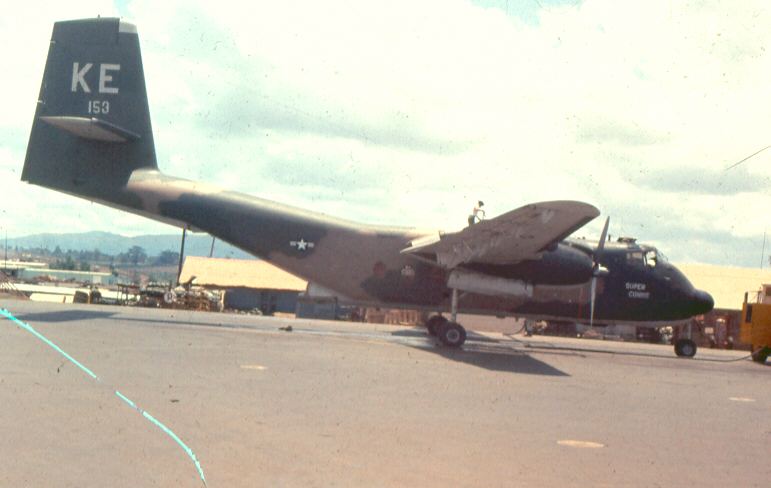 The
DeHavilland Caribou started out as a US Army transport that was
purchased in the 1950s when the Army was seeking to expand its aviation
forces and wanted a transport of its own. Smaller than a C-123 and with
a much smaller payload, the Caribou was able to land on very short
unimproved runways. When the Army got permission for form an air
assault division, Army Aviation leaders believed they could provide
their own support to their airmobile units using Caribous to airlift
fuel, ammunition and other supplies to landing zones on the
battlefield. It was a belief founded mostly on wishful thinking, and
when the 1st Air Cavalry Division went into combat in the I Drang
Valley in Vietnam in October 1965, the Army learned quickly that the
Caribou lacked the payload to sustain a force of helicopters in combat.
They turned to the Air Force for help and as a result, decided to give
the Caribous up in return for concessions from the Air Force regarding
helicopter development. In the fall of 1966 Air Force pilots began
flying Caribous in Vietnam while Air Force mechanics began maintaining
the "teeny weeny air transports," as they came to be called.
Redesignated as the C-7A, Air Force Caribous proved their worth as
small transports capable of delivering small payloads into very short
runways. Their maneuverability and simple design allowed Caribou crews
to operate in the face of intense small arms fire as they delivered
badly needed supplies to remote camps while under seige. Assigned to
the 483rd Troop Carrier Wing, later the 483rd Tactical Airlift Wing,
Caribous were heavily involved in combat operations in South Vietnam
until the early 1970s.
The
DeHavilland Caribou started out as a US Army transport that was
purchased in the 1950s when the Army was seeking to expand its aviation
forces and wanted a transport of its own. Smaller than a C-123 and with
a much smaller payload, the Caribou was able to land on very short
unimproved runways. When the Army got permission for form an air
assault division, Army Aviation leaders believed they could provide
their own support to their airmobile units using Caribous to airlift
fuel, ammunition and other supplies to landing zones on the
battlefield. It was a belief founded mostly on wishful thinking, and
when the 1st Air Cavalry Division went into combat in the I Drang
Valley in Vietnam in October 1965, the Army learned quickly that the
Caribou lacked the payload to sustain a force of helicopters in combat.
They turned to the Air Force for help and as a result, decided to give
the Caribous up in return for concessions from the Air Force regarding
helicopter development. In the fall of 1966 Air Force pilots began
flying Caribous in Vietnam while Air Force mechanics began maintaining
the "teeny weeny air transports," as they came to be called.
Redesignated as the C-7A, Air Force Caribous proved their worth as
small transports capable of delivering small payloads into very short
runways. Their maneuverability and simple design allowed Caribou crews
to operate in the face of intense small arms fire as they delivered
badly needed supplies to remote camps while under seige. Assigned to
the 483rd Troop Carrier Wing, later the 483rd Tactical Airlift Wing,
Caribous were heavily involved in combat operations in South Vietnam
until the early 1970s.
 One
of the first civil aircraft to be used in the troop carrier role was
the famous Lockheed Lodestar, which the Army designated as the C-60. A
trio of Lodestars were on their way to the Philippines when World War
II broke and out and were diverted to Australia, where they were
appropriated by the Army and assigned to the Far East Air Forces Air
Transport Command, the predecessor of troop carrier forces in the
Southwest Pacific. The C-60 in the photo above was delivering supplies
to the forward airfield at Wanigela Mission in Papaua, New Guinea where
MacArthur's forces established an airhead for the attack on Buna.
One
of the first civil aircraft to be used in the troop carrier role was
the famous Lockheed Lodestar, which the Army designated as the C-60. A
trio of Lodestars were on their way to the Philippines when World War
II broke and out and were diverted to Australia, where they were
appropriated by the Army and assigned to the Far East Air Forces Air
Transport Command, the predecessor of troop carrier forces in the
Southwest Pacific. The C-60 in the photo above was delivering supplies
to the forward airfield at Wanigela Mission in Papaua, New Guinea where
MacArthur's forces established an airhead for the attack on Buna. The
most widely used troop carrier aircraft in World War II was the
militarized Douglas DC-3, which saw service as C-47s and C-53s, with
the difference being that the C-47 was designed to transport cargo
while the C-53 was purchased as a troop carrier without the wide cargo
door. By the end of the war the C-47 designation has become standard.
C-47s served in every theater of teh war and in a variety of roles.
General Dwight Eisenhower referred to the C-47 as one of the three most
important weapons of the war. C-47s also saw wide service in the Korean
War and continued in service into the Vietnam War, when most were
converted into fixed-wing gunships.
The
most widely used troop carrier aircraft in World War II was the
militarized Douglas DC-3, which saw service as C-47s and C-53s, with
the difference being that the C-47 was designed to transport cargo
while the C-53 was purchased as a troop carrier without the wide cargo
door. By the end of the war the C-47 designation has become standard.
C-47s served in every theater of teh war and in a variety of roles.
General Dwight Eisenhower referred to the C-47 as one of the three most
important weapons of the war. C-47s also saw wide service in the Korean
War and continued in service into the Vietnam War, when most were
converted into fixed-wing gunships. Another
airline type that saw wide service in World War II was the Curtiss
C-46, a large twin-engine transport that was used primarily by the Air
Transport Command, particular on the India-China Ferry. The C-46s large
cabin and increased payload led to its adapatation as a troop carrier
transport, but design deficencies quickly revealed that it was
ill-suited for combat. C-46s were only used in one airborne operation,
the crossing of the Rhine in March 1945. The fuel system was prone to
leaks and fuel would run into the belly and pool up, and be easily set
off by tracer bullets. So many were lost in the Rhine operation that
General Matthew Ridgeway, the senior US airborne officer in Europe,
decreed that his troopers would never again jump from C-46s!
Fortunately, the war in Europe ended a few weeks later. Most C-46s went
to reserve units after the war, but were recalled for Korea. C-46s
continued in service into the 1960s, mostly in air commando units
operating in Central America.
Another
airline type that saw wide service in World War II was the Curtiss
C-46, a large twin-engine transport that was used primarily by the Air
Transport Command, particular on the India-China Ferry. The C-46s large
cabin and increased payload led to its adapatation as a troop carrier
transport, but design deficencies quickly revealed that it was
ill-suited for combat. C-46s were only used in one airborne operation,
the crossing of the Rhine in March 1945. The fuel system was prone to
leaks and fuel would run into the belly and pool up, and be easily set
off by tracer bullets. So many were lost in the Rhine operation that
General Matthew Ridgeway, the senior US airborne officer in Europe,
decreed that his troopers would never again jump from C-46s!
Fortunately, the war in Europe ended a few weeks later. Most C-46s went
to reserve units after the war, but were recalled for Korea. C-46s
continued in service into the 1960s, mostly in air commando units
operating in Central America.
Another airline type aircraft adopted
for military service was the Douglas DC-4, which was purchased in large
numbers by the Army as the C-54. C-54s were used primarily by the Air
Transport Command, and by the time the war ended ATC was in the process
of replacing all of its C-46s with them. After the war C-54s were
assigned to troop carrier squadrons, and were the mainstay of the
Berlin Airlift. Two squadrons of C-54s served with the 374th Troop
Carrier Wing in Japan during the Korean War.
 As
the troop carrier mission became crucial to US combat operations in
World War II, the Army sought new designs especially for troop carrier
use. The Fairchild Aircraft C-82 was the most successful of the new
designs, but
it was modified and became the C-119 in time for the Korean War. USAF
C-119s were "loaned" to France for service in Indo-China during the
French Indo-China War. The C-119 was the mainstay of troop carrier
operations through the 1950s. By the 1960s most C-119s had gone to the
reserves. In the mid-sixties many were converted to gunships and some
were given to South Vietnam where they served through the end of the
Vietnam War.
As
the troop carrier mission became crucial to US combat operations in
World War II, the Army sought new designs especially for troop carrier
use. The Fairchild Aircraft C-82 was the most successful of the new
designs, but
it was modified and became the C-119 in time for the Korean War. USAF
C-119s were "loaned" to France for service in Indo-China during the
French Indo-China War. The C-119 was the mainstay of troop carrier
operations through the 1950s. By the 1960s most C-119s had gone to the
reserves. In the mid-sixties many were converted to gunships and some
were given to South Vietnam where they served through the end of the
Vietnam War. Before
World War II ended, the Army Air Forces sought a larger troop carrier
transport. Douglas designed the C-74, which was essentially an
oversized C-54, but it lacked troop carrier capabilities. In response
to a requirement for a large troop carrier aircraft, Douglas redesigned
the C-74 and increased the size of the fuselage. The result was the
C-123 Globemaster. The C-124 immediately became a focal point of
military politics as the commander of the Military Air Transport
Service which had been established in 1948 advocated that such a large
transport rightly belonged in MATS. A C-124 was sent to Japan for
operations into Korea and after the test proved successful, two
squadrons were established at Tachikawa. C-124s remained in TAC and
Pacific Air Forces until 1957 when the Air Force finally gave in to
MATS demands and transferred all of the huge transports to MATS,
although one squadon in Japan remained under PACAF operational control.
Before
World War II ended, the Army Air Forces sought a larger troop carrier
transport. Douglas designed the C-74, which was essentially an
oversized C-54, but it lacked troop carrier capabilities. In response
to a requirement for a large troop carrier aircraft, Douglas redesigned
the C-74 and increased the size of the fuselage. The result was the
C-123 Globemaster. The C-124 immediately became a focal point of
military politics as the commander of the Military Air Transport
Service which had been established in 1948 advocated that such a large
transport rightly belonged in MATS. A C-124 was sent to Japan for
operations into Korea and after the test proved successful, two
squadrons were established at Tachikawa. C-124s remained in TAC and
Pacific Air Forces until 1957 when the Air Force finally gave in to
MATS demands and transferred all of the huge transports to MATS,
although one squadon in Japan remained under PACAF operational control. Another
Chase aircraft design was the C-123 Provider, which started out as an
all-metal glider. As the world entered the Jet Age, Fairchild decided
to convert it into a four-engine jet transport, but the Air Force
decided it cost too much. Fairchild then offered it as a twin-engine
assault transport, an airplane that could land on very short,
unimproved strips and function essentially as a powered glider. The
first C-123Bs went to a troop carrier squadron at Ardmore AFB,
Oklahoma. By the early 1960s the C-123s were being phased
out, with only a handful of squadrons still flying
them in the active Air Force while reserve squadrons at
Memphis, Tennessee and Birmingham, Alabama also operated
them. The two squadrons were called to active duty during
the Cuban Crisis. In 1961 a special conference in Saigon
determined that a major need of the South Vietnamese government in its
war against insurgents was air transportation and the Air Force
proposed that this need be met with C-123s. In early December a
squadron departed from Pope AFB, NC for Clark AB, Philippines as
Project MULE TRAIN. Within a few weeks the project had moved to Saigon.
They were joined a few months later by another squadron which deployed
as SAWBUCK. In 1963 the temporary duty C-123s and their crews and
support personnel were replaced by permanently assigned aircraft and
personnel drawn from the Air Force at large. Assigned to the 315th Air
Commando Group, C-123s would serve in Southeast Asia as short-range
assault transports until the early 1970s.
Another
Chase aircraft design was the C-123 Provider, which started out as an
all-metal glider. As the world entered the Jet Age, Fairchild decided
to convert it into a four-engine jet transport, but the Air Force
decided it cost too much. Fairchild then offered it as a twin-engine
assault transport, an airplane that could land on very short,
unimproved strips and function essentially as a powered glider. The
first C-123Bs went to a troop carrier squadron at Ardmore AFB,
Oklahoma. By the early 1960s the C-123s were being phased
out, with only a handful of squadrons still flying
them in the active Air Force while reserve squadrons at
Memphis, Tennessee and Birmingham, Alabama also operated
them. The two squadrons were called to active duty during
the Cuban Crisis. In 1961 a special conference in Saigon
determined that a major need of the South Vietnamese government in its
war against insurgents was air transportation and the Air Force
proposed that this need be met with C-123s. In early December a
squadron departed from Pope AFB, NC for Clark AB, Philippines as
Project MULE TRAIN. Within a few weeks the project had moved to Saigon.
They were joined a few months later by another squadron which deployed
as SAWBUCK. In 1963 the temporary duty C-123s and their crews and
support personnel were replaced by permanently assigned aircraft and
personnel drawn from the Air Force at large. Assigned to the 315th Air
Commando Group, C-123s would serve in Southeast Asia as short-range
assault transports until the early 1970s. Developed
during the Korean War as a medium range transport with unimproved
runway capabilities, the Lockheed C-130 Hercules has become the
penultimate troop carrier transport. First flown in 1953, C-130s began
replacing C-119s in Tactical Air Command troop carrier squadrons
beginning in December 1956. Originally planned for six squadrons in the
United States and six overseas - three each in the Pacific and Europe -
by the mid-1960s there were twelve squadrons in the Pacific alone.
PACAF C-130s assigned to 315th Air Division were involved in Southeast
Asia from the beginning of hostilities as a logistical transport and in
June 1965 the first airplane were assigned to South Vietnam, although
on temporary duty status, for tactical operations. By 1968 C-130s were
heavily involved in the combat role as well as logistical supports.
315th Air Division C-130s were also involved in then-classified
"special operations" missions including flying forward air
controller/flare missions over the Ho Chi Minh Trail in Laos, dropping
leaflets over North Vietnam - and North Korea - and in several other
missions of a classified nature. In 1969 the 473rd Tactical Airlift
Wing began COMMANDO VAULT missions dropping 10,000-pound bombs, later
replaced by newly designed 15,000 pounders. By 1972 PACAF C-130s were
the only USAF tactical airlifters involved in the war in Vietnam, the
C-123s having been withdrawn or given to the South Vietnamese. In 1975
all USAF tactical airlift resources transferred to the Military Airlift
Command.
Developed
during the Korean War as a medium range transport with unimproved
runway capabilities, the Lockheed C-130 Hercules has become the
penultimate troop carrier transport. First flown in 1953, C-130s began
replacing C-119s in Tactical Air Command troop carrier squadrons
beginning in December 1956. Originally planned for six squadrons in the
United States and six overseas - three each in the Pacific and Europe -
by the mid-1960s there were twelve squadrons in the Pacific alone.
PACAF C-130s assigned to 315th Air Division were involved in Southeast
Asia from the beginning of hostilities as a logistical transport and in
June 1965 the first airplane were assigned to South Vietnam, although
on temporary duty status, for tactical operations. By 1968 C-130s were
heavily involved in the combat role as well as logistical supports.
315th Air Division C-130s were also involved in then-classified
"special operations" missions including flying forward air
controller/flare missions over the Ho Chi Minh Trail in Laos, dropping
leaflets over North Vietnam - and North Korea - and in several other
missions of a classified nature. In 1969 the 473rd Tactical Airlift
Wing began COMMANDO VAULT missions dropping 10,000-pound bombs, later
replaced by newly designed 15,000 pounders. By 1972 PACAF C-130s were
the only USAF tactical airlifters involved in the war in Vietnam, the
C-123s having been withdrawn or given to the South Vietnamese. In 1975
all USAF tactical airlift resources transferred to the Military Airlift
Command.  The
DeHavilland Caribou started out as a US Army transport that was
purchased in the 1950s when the Army was seeking to expand its aviation
forces and wanted a transport of its own. Smaller than a C-123 and with
a much smaller payload, the Caribou was able to land on very short
unimproved runways. When the Army got permission for form an air
assault division, Army Aviation leaders believed they could provide
their own support to their airmobile units using Caribous to airlift
fuel, ammunition and other supplies to landing zones on the
battlefield. It was a belief founded mostly on wishful thinking, and
when the 1st Air Cavalry Division went into combat in the I Drang
Valley in Vietnam in October 1965, the Army learned quickly that the
Caribou lacked the payload to sustain a force of helicopters in combat.
They turned to the Air Force for help and as a result, decided to give
the Caribous up in return for concessions from the Air Force regarding
helicopter development. In the fall of 1966 Air Force pilots began
flying Caribous in Vietnam while Air Force mechanics began maintaining
the "teeny weeny air transports," as they came to be called.
Redesignated as the C-7A, Air Force Caribous proved their worth as
small transports capable of delivering small payloads into very short
runways. Their maneuverability and simple design allowed Caribou crews
to operate in the face of intense small arms fire as they delivered
badly needed supplies to remote camps while under seige. Assigned to
the 483rd Troop Carrier Wing, later the 483rd Tactical Airlift Wing,
Caribous were heavily involved in combat operations in South Vietnam
until the early 1970s.
The
DeHavilland Caribou started out as a US Army transport that was
purchased in the 1950s when the Army was seeking to expand its aviation
forces and wanted a transport of its own. Smaller than a C-123 and with
a much smaller payload, the Caribou was able to land on very short
unimproved runways. When the Army got permission for form an air
assault division, Army Aviation leaders believed they could provide
their own support to their airmobile units using Caribous to airlift
fuel, ammunition and other supplies to landing zones on the
battlefield. It was a belief founded mostly on wishful thinking, and
when the 1st Air Cavalry Division went into combat in the I Drang
Valley in Vietnam in October 1965, the Army learned quickly that the
Caribou lacked the payload to sustain a force of helicopters in combat.
They turned to the Air Force for help and as a result, decided to give
the Caribous up in return for concessions from the Air Force regarding
helicopter development. In the fall of 1966 Air Force pilots began
flying Caribous in Vietnam while Air Force mechanics began maintaining
the "teeny weeny air transports," as they came to be called.
Redesignated as the C-7A, Air Force Caribous proved their worth as
small transports capable of delivering small payloads into very short
runways. Their maneuverability and simple design allowed Caribou crews
to operate in the face of intense small arms fire as they delivered
badly needed supplies to remote camps while under seige. Assigned to
the 483rd Troop Carrier Wing, later the 483rd Tactical Airlift Wing,
Caribous were heavily involved in combat operations in South Vietnam
until the early 1970s.